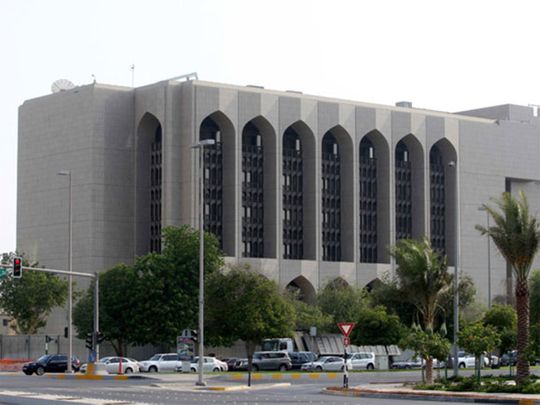
Dubai: The Central Bank of UAE and other leading central banks across the GCC cut their key interest rates late on Wednesday following the lead from the US Federal Reserve, which cut interest rates for the third time this year in a move to boost the flagging economic growth.
GCC central banks in general follow the Fed’s monetary policy lead to maintain exchange rate stability in their respective countries.
Rate cuts announced
Saudi Arabia, UAE and Bahrain, whose currencies are pegged to the US dollar, have announced rate cuts. The CBUAE said on Wednesday that it was cutting interest rates applied on the issuance of certificates of deposits by 25 basis points. The central bank also said the repo rate for borrowing short-term liquidity had been cut by 25 basis points.
Usually Kuwait tends to diverge from the Fed policy cuts to some extent because of its currency’s peg to a basket of currencies rather than a direct peg to the dollar. But because of the dominance of the dollar in the currency bracket, Kuwait too can’t diverge its policy rates for too long.
Kuwait’s central bank cut its benchmark interest rate on Wednesday, joining the Federal Reserve-led monetary easing cycle with its Gulf peers for the first time since July. Kuwait cut its discount rate by 25 basis points to 2.75 per cent from 3 per cent after staying put in July and September when other major Gulf central banks cut rates.
The Saudi Arabian Monetary Authority (SAMA) has decided to lower the repo rate by 25 basis points from 2.5 per cent to 2.25 per cent and the reverse repo rate by 25 basis points from 2 per cent to 1.75 per cent with immediate effect. “Policy Rate adjustments are consistent with SAMA’s objective of maintaining monetary stability,” SAM said in a stetement.
Cost of borrowing
The rates cuts across the GCC countries are expected to reduce cost of borrowing with a positive impact on the debt servicing burdens of corporates and wholesale borrowers. However, analysts do not expect the rate cuts to benefit retail borrowers except those loans whose rates are directly linked to inter-bank rates.
The Fed rate cut comes at a time when leading Gulf economies, especially Saudi Arabia and the UAE, are facing slower growth in the context of regional geopolitical challenges and external headwinds ranging from trade war, lower oil prices, slower global growth and exchange rate appreciation.
Central banks and economists expect lower cost of borrowing is likely to increase investment demand for funds.
“Rate cuts are expected to make borrowing cheaper for investors, since lower US interest rates could put downward pressure on the dollar and thus make the dirham denominated properties more affordable. Weakness in the wholesale and retail trade and construction sectors continues and further appreciation of the dirham real effective terms is hurting key sectors such as real estate, trade and tourism,” said Garbis Iradian, Chief Economist, Middle East and North Africa of the Institute of International Finance (IIF).
The UAE has been facing slowing credit growth combined with rising real effective exchange rates, hurting growth prospects of key non-oil sectors such as real estate and wholesale and retail trade. Lower rates are widely expected address both these concerns to some extent.
“The decision aims to reduce the cost of borrowing in the Kuwaiti dinar, maintain a comfortable margin for the Kuwaiti dinar, and prove a supportive environment for investment,” Kuwait Central Bank said in a tweet.
Theoretically, lower rates are expected to reduce borrowing costs of companies and individuals, however analysts said it is unlikely to result in big increase credit growth to private sector as the regional economies have been slowing in tandem with global slowdown resulting from trade war and geopolitical tensions.
“Concerns on the growth outlook combined fears of asset quality issues are likely to keep banks risk averse while liquidity is abundant in the banking sector. Loan demand from private sector is also largely a function of the economic growth,” said a senior banker.
Margin pressure on banks
Banks across the GCC are expected to face further pressure on their interest margins as they will be forced to reprice loans to lower rats specially rates on wholesale borrowings.
While the region’s banks are hugely dependent on current and savings account deposits which comes with negligible costs, there is little scope for further reducing cost of funding. It essentially means, the net interest margins (the difference between cost of funding and the rates at which loans are advanced) are likely to fall further impacting the profitability of banks
In a rising interest rate environment, banks have the option to reprice their loans to higher rates while deposit rates rise at a lower rate with a lag, resulting in improved interest margins for banks. As the rates drop, the difference between deposit rates and lending rates shrink faster applying pressure on loan yields bank, impacting their profitability.
What lower rates mean for banks, customers and economy
- Lower debt burden for borrowers
- Lower debt servicing costs for individuals and companies
- Lower interest margins for banks (the difference between the interest income of banks and interest paid out to depositors)
- Banks’ profitability to shrink
- Private credit demand unlikely to go up because of economic headwinds
- Lower effective exchange rates to boost local asset classes, especially real estate and sectors such as tourism, retail and hospitality











